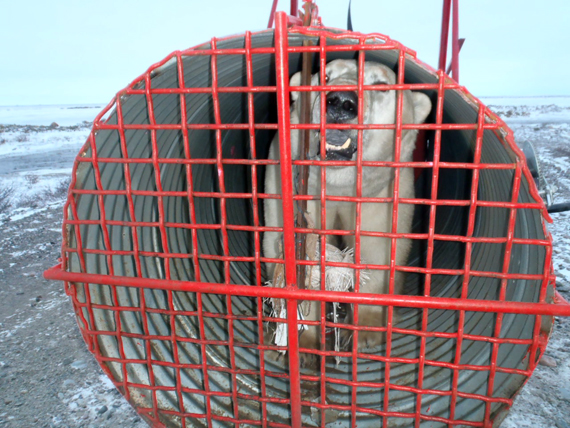Nunavut wildlife officials investigate illegal polar bear killings
Four shot polar bears discovered near Arviat, unharvested and unreported

Wildlife officers capture a polar bear in this luring station outside of Arviat in 2014. The GN is now investigating the recent illegal killing of four bears around the Kivalliq community, just weeks after a resident was mauled to death by the large Arctic predator. (FILE PHOTO)
Nunavut wildlife officials say they’re investigating the illegal killing of four polar bears that were discovered around the community of Arviat in recent weeks.
While there have been two defence kills of polar bears around the Kivalliq communities through the month of July, conservation officers say another four animals were shot and left unharvested and unreported around the community of about 2,700.
The Government of Nunavut’s Department of Environment has launched an investigation into the deaths and said last week that officials are working with Arviat’s hunters and trappers organization to attempt to prevent any further illegal killings.
The deaths come just weeks after an Arviat resident was mauled to death by a polar bear, while he was out collecting eggs with his children on nearby Sentry Island.
Relatives say Aaron Gibbons put himself between the bear and his children to protect them. While he carried a .22 rifle with him on the outing, Gibbons was unarmed at the time the polar bear attacked and killed him.
Someone else on the island arrived and killed the polar bear afterwards.
The GN’s Environment Department sent the polar bear’s body for an autopsy, though the department has yet to release its findings. Some witnesses reported that the polar bear who attacked Gibbons was a young, skinny male.
Since the attack, residents said another polar bear approached a group of people staying in cabins outside the community and continued to threaten the group. That polar bear was shot and reported as a defence kill.
But Gibbons’ death—the first polar bear-related death in the region since 1999—has rocked the Hudson Bay community, which has seen a gradual increase in the number of polar bears coming into the community, leading to dangerous encounters with residents.
Arviat has used the remainder of its polar bear tags, or quota, for the year. While the community has pushed for more tags, some residents have expressed frustration with the territory’s restrictive wildlife management system.
Nunavut’s new premier, Joe Savikataaq, himself an Arviat resident, lobbied hard as environment minister to increase the total allowable harvest of western Hudson Bay polar bears as a way to better manage the population and threats to communities along the coast.
Earlier this year, the Nunavut Wildlife Management Board decided to increase the total allowable harvest by four, bringing Kivalliq’s quota to 38 polar bears per year.




(0) Comments